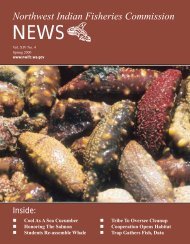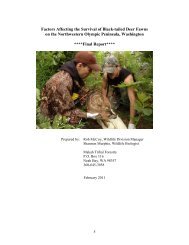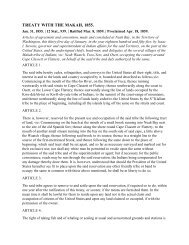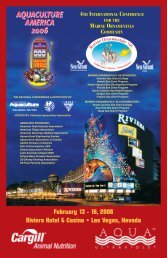Draft TRT Document â for Discussion Purposes ... - NWIFC Access
Draft TRT Document â for Discussion Purposes ... - NWIFC Access
Draft TRT Document â for Discussion Purposes ... - NWIFC Access
You also want an ePaper? Increase the reach of your titles
YUMPU automatically turns print PDFs into web optimized ePapers that Google loves.
<strong>Draft</strong> <strong>TRT</strong> <strong>Document</strong> – <strong>for</strong> <strong>Discussion</strong> <strong>Purposes</strong> – OK to circulateIndependent populations will generally be, but not necessarily, smaller than awhole DPS and will generally inhabit geographic ranges on the scale of whole riverbasins or major subbasins that are relatively isolated from outside migration.Demographically and biologically, independent populations are the primary unit <strong>for</strong>viability assessments and recovery planning.Structure Above the Population LevelJust as there may be substructuring within a population, there may be structureabove the level of a population. This is explicitly recognized in the designation of a DPSor an evolutionarily significant unit (ESU). A DPS or ESU may contain multiplepopulations that are connected by some common element. Thus organisms can begrouped into a hierarchical system in which we define the levels from individual tospecies. Although reproductive isolation <strong>for</strong>ms a continuum, it probably is not a smoothcontinuum, and there is a biological basis <strong>for</strong> designating a hierarchy of levels. Theconcept of “strata” was developed by the Willamette Lower Columbia River <strong>TRT</strong> to helpdescribe, where necessary, a level of structure intermediate between populations andDPSs (McElhany et al. 2003). A similar multiple population unit was developed <strong>for</strong>Chinook salmon by the Puget Sound <strong>TRT</strong> (Geographic Regions) and the InteriorColumbia River <strong>TRT</strong> (Major Population Groups). For consistency, the term MajorPopulation Groups (MPGs) has been adapted by the <strong>TRT</strong>s to describe these populationaggregates. MPGs are generally used to capture major life history differences, distinctecological zones, and/or geographic structuring. Where specific in<strong>for</strong>mation was notavailable we considered implied life history differences to exist where populationsoccupied a suitably large geographic region with unique ecological conditions (e.g.hydrology, thermal regime, estuarine conditions, etc.). Previous <strong>TRT</strong>s have underscoredthe importance of MPGs by including them in the viability criteria. While criteria <strong>for</strong>DPS viability vary among the <strong>TRT</strong>s, there is some provision in all <strong>TRT</strong> viability criteriarequiring the viability of all extant MPGs. Previous <strong>TRT</strong>s identified MPGs inconjunction with the development of viability criteria; we have elected to concurrentlydefine DIPs and MPGs prior to establishing viability criteria.Structure Below the Population LevelBelow the population level there often will be aggregations of fish that are tosome degree reproductively isolated from other groups of fish within the population, butthat are not sufficiently isolated to be considered independent by the criteria adoptedhere. These fish groups are referred to as subpopulations. Subpopulations play animportant role in the sustainability and evolution of populations. However fewpopulations have been studied sufficiently in depth to characterize any componentsubpopulations. The presence of subpopulations can have important consequences in thecharacterization of a VSP. Additionally, subpopulations can strongly influencepopulation spatial structure, one of the four key parameters <strong>for</strong> evaluating the status of apopulation. Where possible, the <strong>TRT</strong> endeavored to describe internal variability in lifehistory, ecological, or geographic structure <strong>for</strong> each population. For example, in somesteelhead populations winter- and summer-run fish appear to co-mingle. At present thereis insufficient in<strong>for</strong>mation to determine the degree to which these two life history types6









